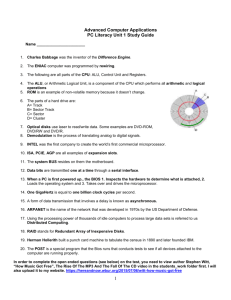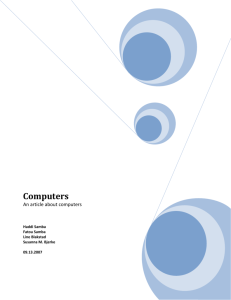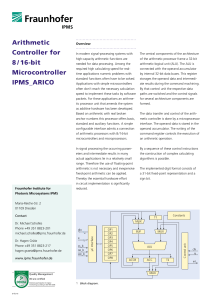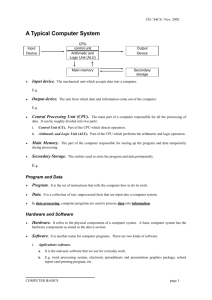Design steps of ALU - Soon , UniMasr.com will be Zamayel.com
advertisement
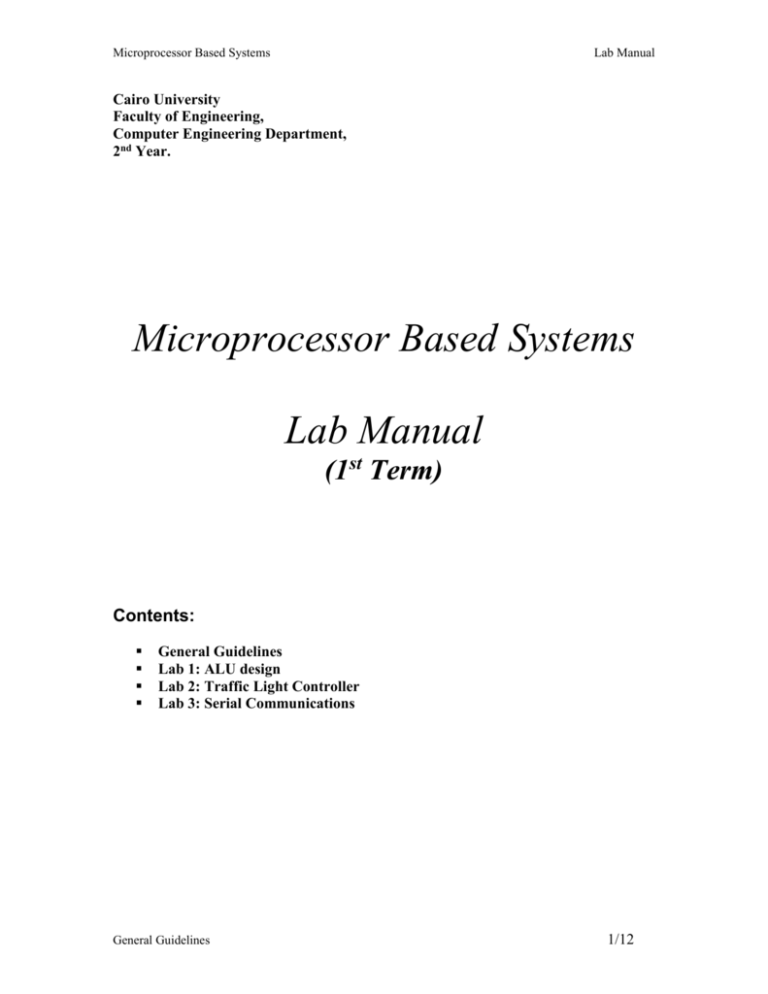
Microprocessor Based Systems
Lab Manual
Cairo University
Faculty of Engineering,
Computer Engineering Department,
2nd Year.
Microprocessor Based Systems
Lab Manual
(1st Term)
Contents:
General Guidelines
Lab 1: ALU design
Lab 2: Traffic Light Controller
Lab 3: Serial Communications
General Guidelines
1/12
Microprocessor Based Systems
Lab Manual
General Guidelines
Format of Lab Reports
Although the assignments specify certain information to be included in the reports, all
reports should include some standard information and follow a standard format. All
reports should be typed, well-organized, grammatically correct, neat, and fastened using
either a staple in the upper left corner or a report binder. All reports should be concise.
All reports should have the following components, discussed below, in the given order.
1. Title Page
2. Validation Sheet(s)
3. Main Body of the Report
4. Program Listing(s)
5. Comment Sheet
a. Title Page
The title page should be the first page of the report and must include the following
information.
Cairo University
Computer Engineering Department
Experiment # ??
Experiment Title
NAME:
Section: ?
Date: ?
b. Validation Sheet
A validation sheet is a page where you write the summary of your results or
observations,... etc. and then you get a teaching assistant to sign it for you verifying your
statements.
Insert the validation sheet into the report immediately after the title page.
c. Main Body of the Report
In addition to specific information required for each assignment, the main body of the
report should provide the following general information. The information should be
brief and concise, yet complete.
Brief problem statement.
Description of the solution, using figures as appropriate.
Description of the design including pseudo-code, schematics for new hardware, etc.
(see Documentation Guidelines).
Expected and observed results and performance.
General Guidelines
2/12
Microprocessor Based Systems
Lab Manual
d. Program Listing(s)
The report should include the listing file for the program(s). Organize the listing file
using comments and assembler directives. Print the listing in a neat manner, especially
avoid unnecessary line breaks. Separate the printer output and insert the pages in the
report following the main body of the report.
e. Comment Sheet
Please take time to submit a comment sheet and attach it as the last page of the report.
Your comments will be used to improve the project assignments, laboratory equipment,
etc. Your input is valuable and greatly appreciated.
Documentation Guidelines
In addition to the text of your report, your design must be documented by schematic
diagrams, pseudo-code, and listing file. Good documentation that can be easily
understood by others, is neat and well organized, and conveys all necessary information
in a complete, yet concise, manner. Some specific guidelines for schematic diagrams and
pseudo-code are given below.
1. Schematic Diagrams
Guidelines for preparing schematic diagrams are given below.
1. All diagrams must be neat and legible. You may draw diagrams neatly in pencil
using a template or use a schematic capture or drawing program to generate
diagrams.
2. Label the overall circuit with a title block. Give a drawing or page number for
multipage diagrams.
3. Use standard logic symbols.
4. Label all components with unit numbers, e.g. U1, U2, etc., that appear in a parts
list.
5. Indicate all power and ground connections either as pins on the first unit of a
component, e.g. U1, or in the parts list.
6. Label all signals using unique names that are understandable and describe the
function of the signal.
7. Use label cross references to avoid massive and confusing line drawing and to
continue a signal to another page.
8. Signal lines that connect should be indicated with a heavy dot or “blob,” while
lines that cross without connecting should be shown as crossing lines. Do not use
curves or “bumps” in lines to indicate that there is no connection.
9. Organize inputs and outputs by function so as to keep related signals together and
to minimize line crossovers and length. There is no need to make you drawing
confusing in order to maintain pin ordering.
10. You may merge multiple signals that operate as a group, e.g. a data or address
bus, into a single line. Labels should clearly indicate the signals in the bus.
11. As much as possible, logic and signal flow should go from top-to-bottom (inputs
at top, outputs at bottom) or left-to-right (inputs at left, outputs at right).
General Guidelines
3/12
Microprocessor Based Systems
Lab Manual
2 Pseudo-code
A few rules for pseudo-code are listed below.
1. Use high-level, meaningful terms for functions and variables. Do not use actual
microprocessor instructions or register references.
2. Do not substitute a paragraph description for pseudo-code.
3. Use assignment statements, subroutine calls, macro names, and control structures
such as “if-then-else" or “do-while.”
4. Use more than one level when necessary. For example, write pseudo-code for the
main program that specifies subroutines by name, and then write pseudo-code for
each subroutine.
5. Organize pseudo-code by using indentation and spacing.
General Guidelines
4/12
Microprocessor Based Systems
Lab Manual
Lab 1
ALU Design
Objectives
-Introducing one of the basic computer components, ALU.
-Reviewing combinational circuit design.
-Practicing the use of design simulators (Altera-Max Plus 2 or Quartus II).
ALU: a Brief Introduction
An arithmetic logic unit (ALU) is a combinational circuit that performs a set of basic
arithmetic and logic micro-operations. Because the ALU can perform many operations.
There should be a number of selection lines to select a particular operation in the unit.
Figure 1 shows the block diagram for a typical 4-bit ALU.
Data
input
A
A0
A1
A2
A3
Data
input
B
B0
B1
B2
B3
Input carry
{
Function select
Mode select
Cin
4-bit
ALU
F0
F1
F2
F3
Cout
Data
output
F
Output carry
S0
S1
S2
Figure 1: Block Diagram of a 4-bit ALU.
The circuit accepts two 4-bit data inputs (A and B). Depending on the operation, it
generates an output F. The mode select input S2 distinguishes between arithmetic and
logic operations. The two function-select inputs S1 and S0 specify a particular arithmetic
or logic operation to be generated at the output lines. With three selection lines, it is
possible to specify four arithmetic operations and four logic operations. The input and
output carries have meaning only during arithmetic operations.
Lab 1 – ALU Design
5/12
Microprocessor Based Systems
Lab Manual
The following table shows some examples of ALU operations.
Operation Select
S2 S1 S0 Cin
0
0
0
0
0
0
0
0
1
1
1
1
0
0
0
0
1
1
1
1
0
0
1
1
0
0
1
1
0
0
1
1
0
1
0
1
0
1
0
1
0
1
0
1
0
0
0
0
Output
F
A
A+1
A+B
A+B+1
A+B`
A+B`+1
A-1
A
A AND B
A OR B
A XOR B
A`
Function
Transfer A
Increment A
Addition
Add with carry
A plus B’s one’s complement
Subtraction
Decrement A
Transfer A
AND
OR
XOR
Complement A
Notice how the input carry Cin is used as a fourth selection variable for arithmetic
operations. In this way the arithmetic operations are doubled from four to eight.
Design steps of ALU
The design of a typical ALU is carried out in three steps:
1- Designing the arithmetic section.
2- Designing the logic section.
3- Combining the two sections to form the desired ALU.
Figure 2 shows one stage of the 4-bit ALU described in Figure 1.
Ci
Ai
Bi
Ci+1
One stage of
arithmetic
circuit
0
MUX
Fi
1
S0
S1
Select
One stage of
logic circuit
S2
Figure 2: One stage of the 4-bit ALU.
Lab 1 – ALU Design
6/12
Microprocessor Based Systems
Lab Manual
As shown, one stage of arithmetic circuit is combined with that of logic circuit to
produce one stage of ALU. Selection lines S1 and S0 can be common between both
circuits provided that the third selection S2 is used to differentiate between the two. As
shown in figure 2, the outputs of the arithmetic and logic circuits in each stage are
applied to a 2x1 multiplexer with selection line S2. When S2 is 0, the arithmetic output is
selected, and when S2 is 1, the logic output is selected. The figure shows just one stage of
the ALU. This circuit must be repeated n times for an n-bit ALU.
Points of Guidance for such Design Problems
12-
Start by drawing a block diagram for the circuit identifying inputs and output.
Simplify your design problem into a set of simpler design problems. This is done
by dividing your design into its basic components. Draw each component showing its
inputs and outputs.
3Repeat step 2 recursively until you reach a component that can be implemented
directly giving the available material.
4For each component defined in step 3,
Draw the circuit logic diagram.
Find out the types and the number of ICs required.
5Implementation issue: A good design is the one with min. number of ICs (not
min. number of gates). Try to minimize the number of ICs required for your design.
Lab 1 – ALU Design
7/12
Microprocessor Based Systems
Lab Manual
Design Problem
Requirements:
Use a design simulator to design a 4-bit Arithmetic Logic Unit that accepts 2 4-bit inputs,
A and B, 4 control signals, s3s2s1s0, and carry in, ci, and produce a 4-bit output, F, and
carry out, co, (when appropriate), such that F could be one of the following 15 outputs
depending on the control signals.
Output F
0
A+1
A+B
A+B+ci
A+B`+ci
A+B`+1
A-1
A
AB
AB
AB
A`
Shr A
Shl A
AL*BL
Operation
Clear
Increment
Add
Add with carry
Sub with borrow
Sub
Decrement
Transfer
AND
OR
XOR
Complement
Shift right A
Shift left A
Multiply lower nibbles
Available Material:
Available ICs: 1-bit Binary Adder, 4-to-1 MUX, 2-to-1 MUX, 2-input (AND, OR,
NAND and XOR) gates and Inverters.
Note: Best grade for min. Number of ICs (not min. number of gates).
By the way, a typical ALU chip is the 74181 which is capable of performing several
arithmetic and logic functions. The 74181 has five function selection inputs M, S3, S2,
S1, and S0 and a “carry” input to calculate the outputs.
Lab 1 – ALU Design
8/12
Microprocessor Based Systems
Lab Manual
Lab 2
Traffic Light Controller
Objective:
- Design, Build, and Test a traffic light controller.
Requirements:
Design, build, and test a hardware circuit for a traffic light controller.
N
W
E
S
System Description:
There are four sensors embedded in the roadway (North (N) sensor, South (S) sensor,
East (E) sensor, and West (W) sensor). Data switches may be used to implement the
sensors.
When a car has been detected waiting at a red light, the counter should count 12 pulses
before it turns the green light of the other direction to yellow. The yellow light should
remain on for 4 pulses and then turn red, simultaneously turning the red light on the other
road to green.
Since N/S Red is the complement of E/W Red, a flip-flop can be used to give the reds.
The flip-flop toggles every 16 seconds. Once a mod sixteen counter has been connected
to a flip-flop, the only additions are a few gates to indicate when the yellow and green
lights are ON. For example, N/S Yellow is ON whenever E/W Red is ON and the count
is between 12 and 15. It can be assumed that the green light is a particular direction is ON
when the red and yellow light of the direction is not ON.
If a vehicle stops at a red light makes a right turn, the counter should stop (provided no
yellow light is ON). To cause the counting to continue, another vehicle must stop at a red
light.
Design aspects in detail:
Some of the information given below may appear obvious but in the design process it is
always useful to have all facts stated explicitly.
0) At any given instance both directions are not red.
1) Initially, assume some direction has the red light ON and the other the green light
ON.
2) No cars in either direction ---- No change. ( If a car stops at a red light and makes
a right turn then the count must start and as soon as the car leaves it should stop.)
3) Cars in only one direction ---- that direction remains green.
4) Cars in both directions ---- lights toggle every 16 seconds. (Yellow light of the
direction that has the green light ON turns ON after 12 seconds. i.e. the yellow
light is ON for the last 4 seconds.
Lab 2 – Traffic Light Controller
9/12
Microprocessor Based Systems
Lab Manual
5) If any yellow light is ON, the count continues even if there are no cars waiting.
6) Use six LEDs to represent N/S red, N/S yellow, N/S green, E/W red, E/W yellow,
E/W green.
7) Since the counter chip (7493) has no “stop count” position the starting and
stopping of the counter is achieved by turning on or off the clock as and when
needed.
Points of guidance
1- Start by drawing a block for the circuit showing its main components.
2- Use clock of frequency 1 Hz for the counter.
3- Use switches to simulate sensors. Only 2 switches are required; one for N/S
direction, and one for E/W direction.
4- Read the design description then write down the logic equations for:
a. The counter enable conditions.
b. The flip-flop toggle conditions.
c. The output LEDs of the circuit; N/S red, N/S yellow, N/S green, E/W red,
E/W yellow, E/W green.
5- Given the available material, design a logic circuit for each of the above
equations.
Available Material
- Digital-Analog Training System.
- 4-bit Counter (7493)
- JK flip flop (7476)
- 2-input (AND, OR, NAND and NOR) gates and Inverters.
Lab 2 – Traffic Light Controller
10/12
Microprocessor Based Systems
Lab Manual
Lab 3
Serial Communications
Objective:
- To be familiar with PC serial ports.
Requirement:
Connect two PCs directly through their serial port and write a program that splits the
screen into two halves. The upper half displays what is being typed on the PC and the
lower half displays what is being typed on the other PC.
Guide Lines:
1. Take care when you are constructing your cable connection that both computers are
DTEs so you need switch pin 2 and 3.
2. The program may contain two main procedures. One procedure for initializing the
UART and the other procedure should detect any pressed keys and transmit it serially
as well as detecting any received characters on the serial port.
a. The first procedure is to be written for initializing the UART
(baud rate, parity, data bits, stop bits,…) using IN/OUT
instructions to the corresponding I/O ports without using the
BIOS functions (interrupts). Use the same parameters on both
terminals. Since you are connecting only two DTEs, they nee,,d
not have I.Ds. (Remember that you could always use the BIOS
function Int14h/AH=00h for initialization).
b. You can use the BIOS function Int10h/AH=00h to clear the
screen. (You could always go to the V-RAM directly to clear
the screen). Setup your variables for the upper and lower
halves of the screen. You could use different colors
(attributer) for the upper and lower halves. You could also
use windowing BIOS functions to support upper and lower half
scrolling. For example; the following code uses Int 10h/AH=06
to initialize a window [(0,0) to (79,12)] or scroll window
contents up
mov ah,6
mov al,1
mov bh,7
mov ch,0
mov cl,0
mov dh,12
mov dl,79
int 10h
Lab 3 –
; function 6
; scroll by 1 line
; normal video attribute
; upper left Y
; upper left X
; lower right Y
; lower right X
11/12
Microprocessor Based Systems
Lab Manual
c. The second procedure should detect any pressed keys and transmit it serially
as well as detecting any received characters on the serial port.
i. If a key is pressed then a character is in the keyboard buffer (use the
BIOS function Int 16h/AH=01h to check if a character is available in
the keyboard buffer) then read it and display it in the upper half of the
screen and send it to the UART using an Out instruction. If a character
is present you could read it using Int16h/AH=00h, then display it at
any place on the screen. Use the BIOS functions Int10h/AH=2 to set
the cursor position to the upper half of the screen then use
Int10h/AH=9 to display the character on the screen at the preset cursor
position.
ii. If a character is in the UART RDR (Receiver Data Register) then read
it (using an In instruction) and display it in the lower half of the
screen. You can check if a character is available in the UART RDR by
reading the LSR (Line Status Register) using direct IN access from the
UART RDR I/O Port, or by using the BIOS function Int14h/AH=3
which returns the LSR in AH. After reading the LSR check the Least
Significant Bit. If it is high then a new byte is received in the RDR and
is waiting to be read, otherwise the RDR is empty. You could read the
RDR character using the BIOS function Int14h/AH=02h or by direct
Input from the appropriate I/O port for the RDR. Finally use
Int10/AH=2 to set the cursor position to the lower half of the screen,
then use Int10/AH=9 to display the character at this position.
iii. You scroll the upper and lower half of the screen independently.
Int10h can be used for that also.
iv. The above steps should be repeated until one of the users presses the
ESC key. (The ASCII for ESC=27).
Lab 3 –
12/12
